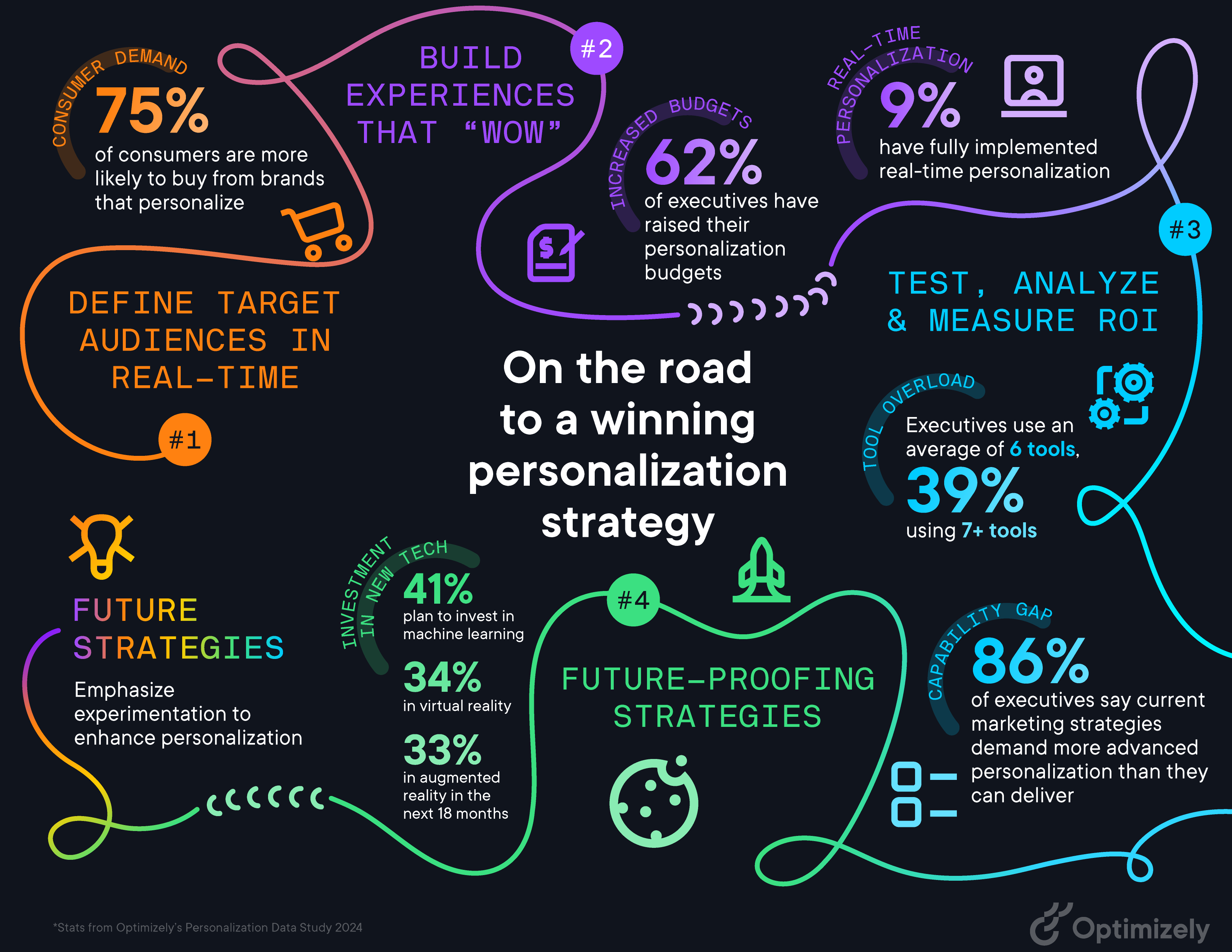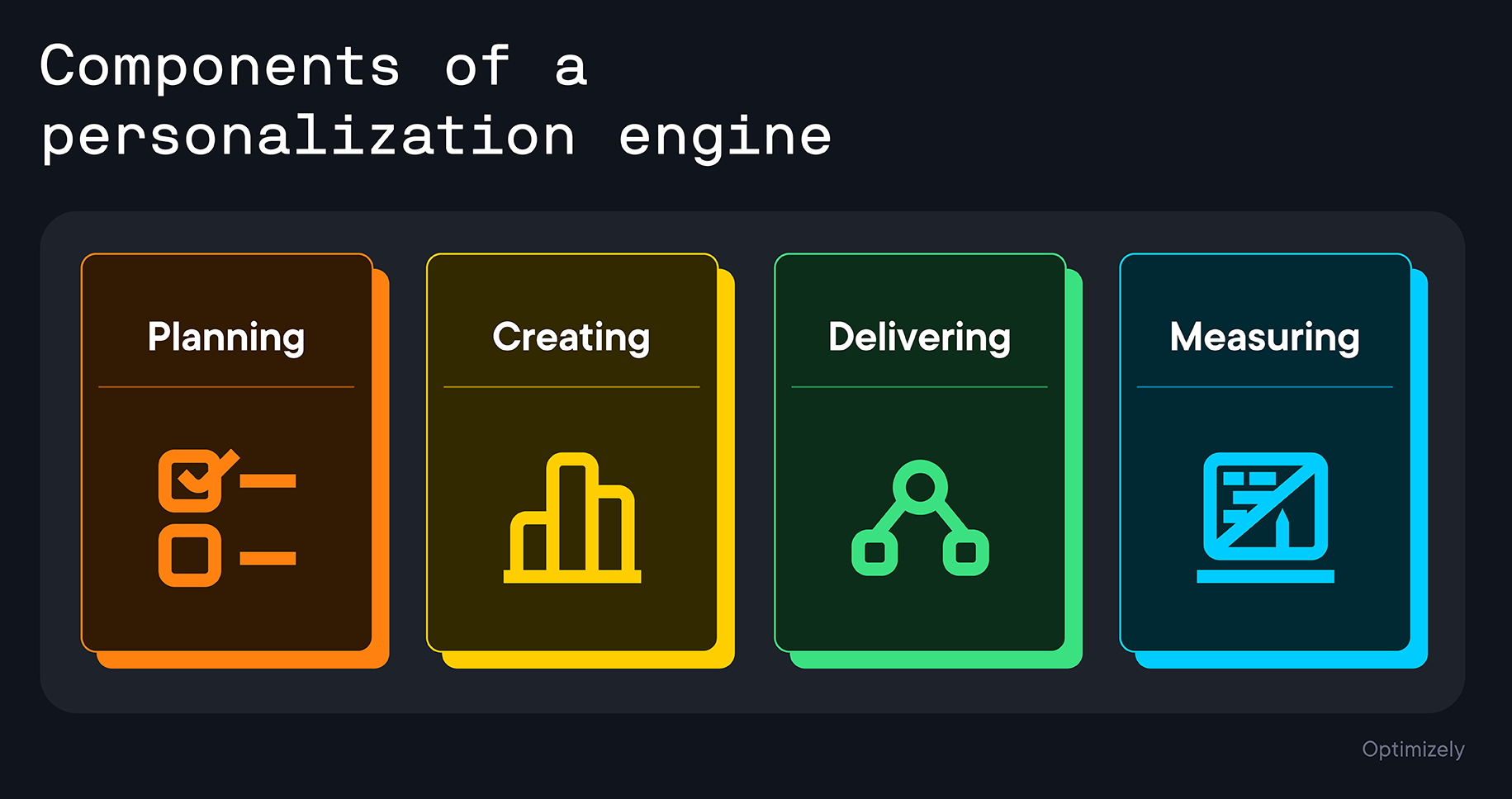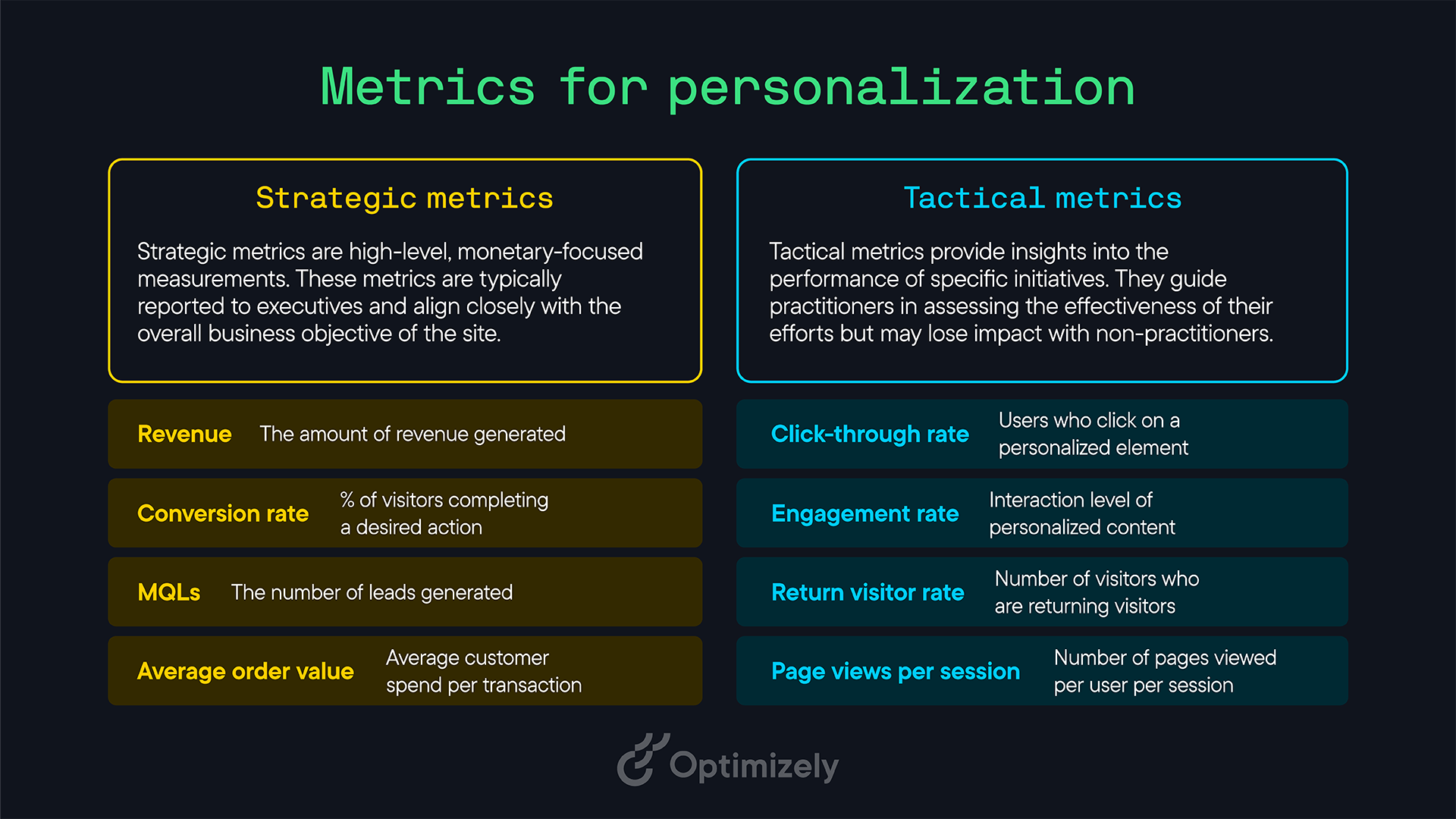Picture this: A customer lands on your website, and it's like you've read their mind. The offers are spot-on, the content is relevant, and they're thinking, "Wow, this brand gets me."
That's the power of a personalization engine.
In essence, it's a sophisticated platform that leverages data and algorithms to deliver uniquely tailored experiences across every touchpoint. We're not just talking about basic segmentation; we're talking about creating a 1:1 connection that resonates with each individual.
But here's the distinction: Personalization is proactive and data-informed (think recommending products based on browsing behavior), while customization is user-directed (like allowing customers to select their preferred email frequency).
The core ingredients? Data collection, insightful analysis, and seamless content delivery. In today's competitive landscape, personalization is the key to cutting through the noise and forging meaningful customer relationships.
Brands that aren’t investing heavily into personalizing the customer experience are poised to fall behind those that are. One of the ways to ensure you can make sure this doesn’t happen is to adopt a personalization engine, whether on your own or with an end-to-end solution.
What is a personalization engine?
A personalization engine is a stack of tools, solutions, and workflows an organization uses to deliver personalized customer experiences. Modern personalization engines leverage rules-based, machine learning, and AI (artificial intelligence)-based systems to create dynamic, context-aware experiences that evolve with user behavior.
How you build your personalization engine will depend heavily on who your customers are, what type of experiences they expect, and the desired business outcomes.

How does a personalization engine work?
So, how do these personalization engines actually work? It's like a finely tuned orchestra, with each section playing a crucial role:
- Data Collection: Think of this as your intelligence-gathering phase. You're pulling in data from everywhere: website interactions, purchase histories, social media buzz, email engagement, and even those trusty CRM systems.
- Data Analysis: This is where the smart stuff happens. We're talking algorithms – often powered by machine learning – that sift through all that data to spot patterns, predict behavior, and segment your audience with laser-like precision.
- Content Delivery: Now for the payoff! Based on those insights, you're delivering personalized content, irresistible offers, and experiences so relevant, they'll make your customers feel like you're psychic. Think personalized product recommendations, targeted content that speaks directly to their needs, and email campaigns that land in their inbox at just the right moment.
- AI's Cameo: And here's where AI steals the show. It's not just a sidekick; it's enhancing every stage, from advanced data analysis to real-time adjustments and automated optimization.
A personalization engine works by continuously analyzing historical and real-time data such as purchase history or human behavior in order to optimize the customer experience. Depending on how you choose to set up your personalization solution, you can either rely on an AI-powered solution to that leverages predictive analytics, or rely on rules-based personalization to automatically route users to a predetermined location on your site or app.
For example, AI can create algorithms that analyze patterns in content consumption and customer behavior to surface more relevant content and product recommendations. Rules-based personalization can trigger actions and dynamically adjust the experience based on specific actions the user takes, such as visiting a pricing page or abandoning a cart. The most powerful personalization engines will leverage both models, depending on the use case.
To execute these functions, you’ll need a multi-layered approach that often includes a bunch of software solutions all working together, such as a customer data platform (CDP), a content marketing platform, an experimentation solution, a dedicated personalization solution, and analytics suite.
What are the use cases of personalization engines?
Ecommerce site personalization
-
Product recommendations: Suggesting relevant items based on browsing and purchase history
-
Dynamic pricing: Adjusting prices based on user segments and shopper behavior
-
Custom category pages: Reorganizing product categories based on user interests
-
Personalized search results: Prioritizing products based on user preferences
-
Automated customer support: i.e. chatbots
Content personalization
-
Article recommendations: Suggesting relevant content based on reading history
-
Dynamic homepage layout: Adjusting content placement based on user interests
-
Custom navigation: Modifying site structure based on user behavior
-
Personalized email content: Tailoring newsletter content to individual preferences
Marketing automation
-
Campaign targeting: Selecting appropriate audiences for marketing messages
-
Dynamic ad content: Adjusting ad creative based on user characteristics
-
Email personalization: Customizing email content and timing via connected CRMs
-
Cross-channel coordination: Maintaining consistent personalization across touchpoints
Benefits of implementing a personalization engine
So, why should you even care about personalization engines? Here's the lowdown:
- Skyrocketing customer engagement: Personalized experiences grab attention like a perfectly timed meme.
- Conversion rates that soar: Tailored offers and content turn browsers into buyers. Cha-ching!
- Customer loyalty that's unbreakable: Personalized experiences build relationships that last.
- ROI that makes your CFO smile: Personalization optimizes your marketing spend and delivers serious results.
AI: the (not so) secret weapon of personalization engines
Let's be honest; personalization just doesn't exist without AI powering it. And it's paying off big time for organizations who have their personalizations operating on all cylinders. Here are just a few ways AI is the foundation for personalization engines:
Revenue and conversion excellence
The financial returns are compelling: Companies implementing AI-powered personalization see an average ROI of 300% within 12 months, with top performers achieving 800%+ ROI. More specifically, personalization can reduce customer acquisition costs by as much as 50%, lift revenues by 5 to 15 percent, and increase marketing ROI by 10 to 30%.
McKinsey research also shows that companies that grow faster drive 40 percent more of their revenue from personalization than their slower-growing counterparts. The market opportunity is staggering—across US industries, shifting to top-quartile performance in personalization would generate over $1 trillion in value.
Enhanced customer experience and engagement
AI personalization dramatically improves customer engagement by delivering content and recommendations that align with individual preferences. When users receive content that resonates with their interests, the results are measurable: higher click-through rates, longer site visits, and increased overall engagement.
The impact on customer satisfaction is equally impressive. Personalization engines streamline the user experience by reducing the effort required to find relevant content or products, creating what customers describe as delightful, intuitive experiences that feel almost magical in their relevance.
Operational efficiency and automation
Beyond customer-facing benefits, AI personalization engines eliminate the constant need to manually boost or bury products. Instead of marketing teams spending hours fine-tuning campaigns, these systems use automation to handle repetitive ranking tasks behind the scenes, freeing teams to focus on strategy and innovation.
Personalization engines also reduce manual effort by automatically optimizing content, offers, and experiences based on real-time performance data. This shift allows businesses to scale personalized experiences across millions of customers without proportionally scaling their workforce.
Long-term customer loyalty and retention
Perhaps most importantly, AI personalization builds stronger customer relationships and drives long-term loyalty. Companies with faster growth rates derive 40% more of their revenue from personalization, largely because personalized experiences create emotional connections that transcend transactional relationships.
What are the components of a personalization engine?

A personalization engine should be comprised of components that encompass the entire lifecycle of the customer journey; from market segmentation to customer engagement to customer retention.
Each of these components can be broken down into 4 layers:
-
Planning component: a solution to bring teams together to collaborate and plan personalization strategies, align with broader marketing strategies, and devise marketing campaigns
-
Creating component: a solution that allows you to create individual customer segments, personalized customer experiences, and the content they want to see
-
Delivering component: an omnichannel solution that decides exactly when, where, and how content and experiences are delivered
-
Measuring component: a solution to analyze, measure and refine results
A powerful personalization platform will allow marketing teams to unify each of these layers from a single dashboard (you knew we were going to plug our personalization solution).
Let’s start with the planning component.
Planning personalization
While not unique to personalization, no campaign will ever be effective without a planning apparatus to drive the strategy.
When it comes to personalization, the planning phase should include 4 key pillars:
- Collaboration: Personalization often brings together individuals from many different teams; from digital marketing to sales to product to engineering and everything in between. Collaborating between team members who are all accustomed to different workflows seems like it should be challenging, but it really isn’t.
- Visualization: Cross-functional teams don’t always speak the same language; engineers and developers are accustomed to sprints whereas marketers and salespeople are accustomed to campaigns. Visual agility is a key component when it comes to planning your personalization campaigns.
- Ideation: Alright, now that everyone’s in the same place and knows what they’re doing, what happens next? It’s time to create workflows that keep everything moving. What’s more, your planning apparatus should make it easy to track concepts, store assets, and communicate efficiently and in a timely manner.
- Visibility: Not everyone needs to see every step of the process, but oftentimes, decision makers will need to step in to offer helpful insight, especially in the event of workflow bottlenecks.
Creating personalized experiences
Without a means of planning, your personalization will stall before it even hits the road, but data is truly the foundation of creating a meaningful personalized experience.
Data collection and segmentation
Bringing your data together sounds about as easy as scaling Mt. Everest while doing a handstand and singing the entire Hamilton soundtrack backwards.
How you collect data, and what data you’re collecting will be the backbone of building your audiences and segmenting your users. Examining companies that leverage data to create personalized experiences and deliver impressive results is great for inspiration. But even better is breaking down the different types of data and what they can potentially tell you about who your users are. Let's look into that.
Early-stage interest
These are signals that show that users are minimally engaged or in an exploratory phase:
- Whitepaper downloads
- Visiting event pages
- Reading blog posts
- Clicking though case studies
- Internal search history
Middle-stage interest
This stage is where you can start to understand user behaviors and really decipher intent:
-
Product overview pages
-
Technical documents
-
Reference videos
-
Product demos
-
Reading customer reviews
It’s at this stage where users are demonstrating a deliberate intent to learn more about your products or services. It’s also the stage where you can start to visualize specific personas.
Late-stage interest
Finally, this is the stage where it’s clear that users are considering making a purchase. Some signals may include:
- Repeat page visits
- Pricing information
- Feature comparisons
- Demo information
- Previous purchase history
- Searching by size, color, or other attributes
Once you begin to factor in market segmentation data points like demographic, geographic, and psychographic signals, you can see how complex customer profiles can become and why having a personalization engine operating underneath it all is so crucial to delivering the experiences that will make a difference.
Delivering personalization
Once you have your planning strategy, content strategy, and data in place, it’s time to actually deliver those personalized experiences to your users.
Who are you delivering personalized experiences to?
Who you deliver to is primarily dependent on how you’ve constructed your customer segments.
Some experiences are pretty simple; geolocation and repeat purchases are very clear indicators of what you should be serving to those users to deliver a personalized experience. Once segments become more robust, the process can get complicated.
Many personalization engines will either need to rely on a robust amount of historical data or real-time segmentation to get as granular as possible.
For example, a customer who’s only purchased white or black sneakers might be greeted with ads or recommendations for similar sneakers. But what if they’re searching for brown sneakers? Real-time segmentation that’s lightning fast will pick up on these evolving user behaviors before it’s too late.
Measuring personalization success

When you deliver hyper-personalized experiences, customers will be more likely to purchase, purchase again, and keep coming back.
Depending on your KPIs and desired outcomes, measuring personalization comes down to how you’re tracking customer journeys and what tools you’re using to stay organized.
And yea, we know. Bringing more tools into the equation sounds about as fun as chewing cardboard. But an effective personalization engine will allow you to measure success by:
- Tracking user engagement across multiple channels via symmetric experiences
- Surfacing results that allow you to iterate through a/b testing or other methods of experimentation
- Executing statistical significance and confidence via holdbacks (a designated amount of traffic that is held back in order to establish a control in your personalization campaign)
- Demonstrating ROI by analyzing purchase history and real-time behavior
Conclusion
Personalization engines are in the early stages of maturity, and yet they’re evolving more quickly than ever.
Understanding which personalization engine you choose to implement or how you choose to build it yourself will have massive implications on the overall customer experience.
As technology continues to evolve, personalization engines will become increasingly sophisticated, offering even more opportunities for meaningful customer interactions. Organizations that are able to harness these changes are poised to win out against those that don’t.
- Last modified: 7/31/2025 9:57:08 PM
